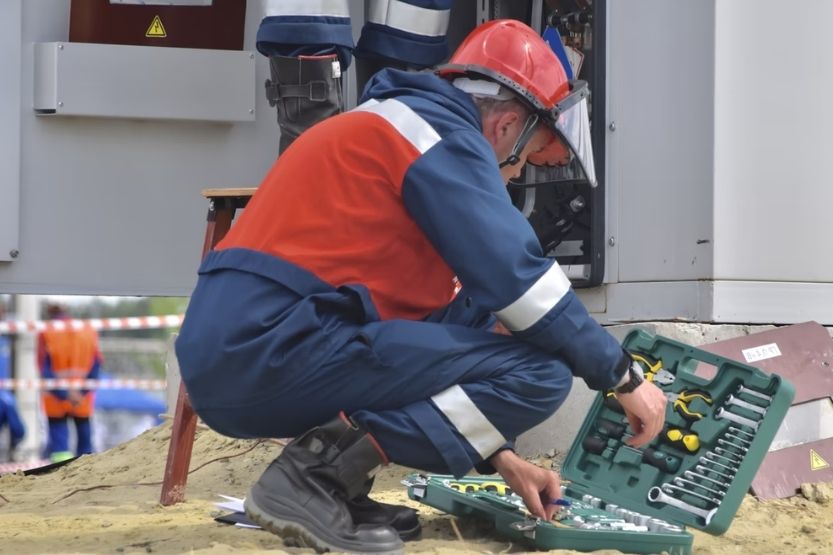Transformers are critical components of cities, suburban, and urban areas. If they fail, problems could quickly follow. In this article, I’ll focus on how long it takes to repair a transformer and why it happens in the first place.
Distribution transformers are responsible for converting voltage into a form that’s suitable for household and commercial use. If they stop working or explode, it could take one hour or longer to replace. However, it might take longer to repair if the damage is extensive.
Read on to get more in-depth information on transformers—what causes them to fail, how long it takes to repair them, and what you should do when that happens.
What Does a Transformer Do?

Device That Decreases or Increases the Voltage Flowing Through Power Lines
Without transformers, there’s no electricity powering your electronic devices and the appliances and lights in your home. A transformer is a device that decreases or increases the voltage that flows through the power lines to an appropriate level for commercial, industrial, and residential use.
Distribution Transformers
Distribution transformers are the transformers on a pole that you see outside of your home. There are around fifty residential homes connected to a single transformer. Meanwhile, about four to five commercial and industrial consumers with high loads can connect to a single transformer.
How Does a Transformer Work
So, how does a transformer work?
Power plants produce a lot of electricity for different areas. Once it’s ready for distribution, those large amounts of electricity have to travel through those thick overhead cables and lose energy during the process. Typically, power plants use high voltage for long distances to prevent energy loss.
The problem with high voltage is it’s too dangerous for residential use. This is where transformers are useful. Power plants use them to boost or “step up” the voltage to the appropriate level when delivering electrical energy over long distances.
Once this electricity reaches its destination, distribution transformers decrease or “step down” the voltage to make it safe and usable in residential and commercial settings.
5 Common Reasons Transformers Fail

Knowing the real cause of transformer failure is crucial to determining the solution and expected repair time. Usually, transformers fail due to different factors that can be classified into external and internal. These can be further classified into electrical, mechanical, and thermal.
The following are five common reasons a transformer fails:
1. Lightning Strikes
Around 30 000 Amps or 300 Million Volts
When lightning strikes a power line, it’s called a “flashover.” Depending on the length and size, a lightning flash can contain around 30 000 Amps (about 300 million Volts). Compare that to the typical household current of 15 Amps (about 120 Volts).
Can Cause Significant Explosion
With the extremely high voltage, lightning bolts could easily cause a significant explosion when they hit power lines. Not only will they damage transformers and wires, but they could also damage appliances and start a fire, especially in dry areas.
Indiana Flashover
In 2012, a flashover that happened in Indiana destroyed Richmond Power & Light’s two industrial transformers. The unfortunate incident cost the company almost $90,000 (and possibly more) in damages. It took them around 20 hours to replace the large industrial transformers that the lightning destroyed.
This kind of accident is preventable if companies will invest in protecting substations or transformers. Unfortunately, there are a lot of small towns that don’t have $20,000 to $150,000 and more to invest in that.
2. System Overload
Transformers Attain Maximum Efficiency at 50-60% Loading
Most electrical transformers are usually highly efficient. Ideally, they can attain maximum efficiency at 50 to 60% loading, or even as high as 99.75% (for 100 MVA and larger electrical transformers).
Transformer Heats Up When Overloaded
An electrical transformer overloads when the currents and voltages are greater than the design specifications on its nameplate. During overloading, it heats up, and eventually, the extremely high temperatures cause its insulation system to weaken. As a result, the life expectancy of the electrical transformer decreases.
Thermal Overload Relay
Generally, every transformer has a protection system against overloads or the thermal overload relay. When electrical current travels through a transformer’s conductor (winding), the relay will sense when the temperature reaches a predetermined level and disconnect the source to protect the transformer’s insulation system.
Causes of Overloaded Transformer
There are several possible reasons for transformer overloading. In most cases, it happens whenever a power plant gradually increases the load of the transformer. And eventually, the transformer exceeds its capacity, causing an excessive rise in the temperature that prematurely degrades the insulation system.
3. Insulation Failure
One of the most common causes of transformer failure is poor insulation. The insulation of transformers eventually fails because of several factors, including the following:
- Acidity,
- Heat,
- Moisture, and
- Oxidation.
When a transformer’s insulation deteriorates, it could cause a short circuit, which in turn leads to overheating, explosions, and fire.
Insulation Materials in Electrical Transformers
The commonly used insulation materials in electrical transformers are oil and cellulose. Some of the cellulose insulation materials in transformers include the following:
- Paper,
- Pressboard, and
- Transformer board.
The said type of insulation serves as a dielectric (a poor conductor of electric current), provides support for the windings, and promotes better thermal health by providing oil cooling ducts.
In comparison, the oils in most transformers are bio-based, mineral oil, or silicone. Among the three, experts use mineral oil more often because it’s cost-effective and has good electrical and thermal properties.
4. Moisture
Transformers aren’t free from moisture. Over the years, water or moisture collects in many transformers, specifically in the oil. If power plants don’t perform moisture maintenance, transformers 15 to 25 years old will contain around 2.5 to 5% moisture by paperweight, or possibly more.
Sources of Moisture in Electrical Transformers
Common sources of moisture in electrical transformers include:
- Residue after the initial drying out in the factory
- Deterioration of oil insulation
- Deterioration of cellulose insulation
- Ingress of moisture through air
Moisture Renders Insulation Materials Ineffective
Moisture is a significant threat to the insulation materials of electrical transformers. The cellulose insulation becomes scarred while the oil loses its breakdown strength.
All of these lead to a reduction in the effectiveness of their insulating properties, causing electrical defects (e.g., partial discharges), flashovers, and other substation irregularities (e.g., short circuits).
5. External Short Circuit
Causes of Short Circuit
It’s not uncommon for short circuits to happen on electric power and distribution systems. Some of the possible reasons electrical transformers short circuit include:
- Breakdown of insulation due to voltage
- Extreme heat
- Mechanical damage of insulation
- Open-circuit fault (e.g., blown circuit breaker or fuse and failure of current-carrying wire)
Effects of Short Circuit on Electrical Transformers
So, what happens if an electrical transformer short circuits? The result would be an abnormally high secondary current in the system and abnormally low voltage. This will likely lead to excessive overheating and damage to the transformer, resulting in explosions or fires.
6. Other Causes
Here are the possible causes of electrical transformer failure:
- Inappropriate insulation material used
- Poor assessment and management of the area of installation (high moisture, presence of dangerous gases, temperature, and so on)
- Incorrect lightning rods capacity and protection range
- Not enough inspection of the gaskets and valves
- Flaws in the organization of the protection circuits
- Inadequate operation and maintenance
- Lack of inspection of internal and external components
- Natural calamities
- Normal wear and tear
- Abnormal voltage
- No system and equipment in place to protect transformers against lightning strikes
- Deterioration of the insulating material, such as cellulose and oil
- Incorrect switch and relay protection system
Again, how long does it take to fix a transformer? It will take you at least one hour to fix a distribution transformer. The length of time depends on the extent of damage and other factors.
Why Does It Take So Long to Restore Power?

Turnaround Time Depends on the Extent of Damage and Types of Materials Needed
Can electrical transformers be repaired? Definitely!
The process and turnaround time of repairing this electrical equipment vary entirely. It all depends on what’s wrong with them, the extent of the damage, and the type of materials you need to repair, replace, or refurbish.
Repairing Faulty Connections Will Take One to Three Hours
For example, if the problem is an electrical failure due to faulty connections or wiring, workers may take anywhere from one to three hours to fix it. It could take much longer (a few days or even weeks) for them to finish the job if there are severe damages because of the additional work, such as soldering.
But why are some of your neighbors across the street already got their power restored? There’s a good reason for that. It’s most likely they have different circuits. The crew from an electric company will usually inspect those circuits and determine what they need to repair first.
Why Does It Take So Long to Restore Power After Severe Weather?
How about during or after severe weather? Why does it take so long to restore power?
Workers Can’t Get to Affected Area Due to Fallen Trees
There’s no single good explanation for it. There could be fallen trees or strong winds that prevent workers from going to the affected area and doing the necessary work to restore power.
Companies are also not willing to put the lives of their linemen on the line (no pun intended). There are times when they’re met by icy conditions or high winds (25 miles per hour), so they don’t have access to the area.
Assessments Take Time
Workers also perform assessments on the extent of the damage and the equipment they need for the repair. That usually takes a lot of time to do.
Residential areas aren’t usually their top priority when there’s a massive power outage due to transformer failure. Institutions that promote public health and safety—like hospitals and fire stations—usually come first.
What Should You Do When a Transformer Fails?
Learning how an electrical transformer works and why it fails is essential, but it’s even more important to know exactly what to do when it fails. In this section, I’ll list the things you should do when transformers explode or malfunction:
1. Don’t Attempt to Approach
Failed transformers or power lines that are down are extremely dangerous. They can easily cause fires and electrocution. Be sure you and your loved ones, especially your kids or pets, stay away from a failed transformer. Let an experienced technician or the service crew of your utility company handle them.
2. Don’t Go Out
Severe natural disasters create many electrical safety hazards in and out of homes and buildings. If there’s a possibility of a flash flood, move to higher ground to avoid electrocution. If other people are with you, make sure they also stay inside your home.
3. Call Your Utility Company
There’s a great chance that your utility company already knows about the failed transformer but call them anyway. Don’t forget to call 911, too. Provide as much information as you can, such as the location of the blown transformer (or transformers), pole tag numbers, or gate combinations.
After you’ve informed them, go back inside your home or the building you’re currently at. It could take some time for the utility company’s service crew to arrive and fix the cause of the transformer failure, depending on the weather condition, the equipment required, and the root cause of the problem.
4. Unplug Your Home Appliances
There are several reasons why you should unplug your home appliances or any devices that consume electricity. For example, power surges are a possibility. That could damage your appliances, or worse, cause a fire.
So, to keep yourself and your loved ones safe, unplug all of your electronics and home appliances until the power is restored. Also, don’t try to open your refrigerator and freezer to avoid spoiling your food.
Conclusion – How Long Does It Take to Fix a Transformer
There’s no clear answer as to how long utility companies can fix a transformer. There are just too many factors that they need to consider:
- Why did the transformer fail?
- What’s the extent of the damage?
- Do they need to get more workers and use special equipment?
- Do they need to repair or replace the defective transformer?
- Is the affected area readily accessible?
In most situations, if there’s no severe damage to the distribution transformer, experienced workers from your utility company can fix it within an hour or a few hours. It may extend to days or weeks if there’s extensive damage. While waiting for the power to return, make sure to observe the proper safety precautions.
Related reading:
Kicked-In Door [How to Repair/Fix]
Bad Drywall Job – How to Fix It?
Carbon Monoxide Detector Going Off – Causes and How to Fix





